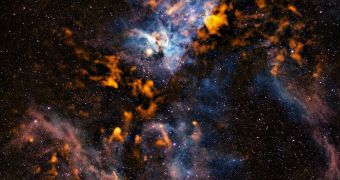A team of German astronomers recently used a Chile-based telescope to scan the depths of the Carina Nebula in submillimeter wavelengths, and managed to identify the dust and gas clouds from which new stars are born inside the stellar nursery.
The Atacama Pathfinder Experiment (APEX) telescope is located on the Chajnantor of the Chilean Andes, and is operated by the European Southern Observatory. It represents a collaboration between ESO, the Max Planck Institute for Radio Astronomy (MPIfR) and Onsala Space Observatory (OSO).
One of the reasons why experts decided to use this particular instrument was because it houses the Large APEX Bolometer Camera (LABOCA) instrument, which is capable of piercing deeply through cosmic clouds, and inside stellar nurseries.
The Carina Nebula was selected as a target for the new investigation because it is known to display frantic stellar formation processes. Together, the latter lead to the formation of some of the most massive stars in the entire Milky Way.
Studying these objects may reveal new insights into the way stars develop and evolve over time. At the same time, this particular nebula can be used to understand how radiations and strong stellar winds from the new stars influence the remnants of the molecular clouds from which they formed.
The investigation was led by experts with the Universitäts–Sternwarte München (USM), Ludwig-Maximilians-Universität (LMU), and the MPIfR, all in Germany. USM/LMU expert Thomas Preibisch and MPIfR investigators Karl Menten and Frederic Schuller were the leaders of the research team.
“At this wavelength, most of the light seen is the weak heat glow from cosmic dust grains. The image therefore reveals the clouds of dust and molecular gas – mostly hydrogen – from which stars may form,” a press release from ESO reads.
“At -250ºC [-418ºF], the dust grains are very cold, and the faint glow emanating from them can only be seen at submillimeter wavelengths, significantly longer than those of visible light,” the statement adds.
This particular image combines orange-colored images collected by APEX LABOCA with visible-light data snapped by the Cerro Tololo Interamerican Observatory's (CTIO) Curtis Schmidt Telescope.
Astronomers were able to determine that the stars inside the Carina Nebula weight over 25,000 solar masses between themselves. Additionally, it was found that the clouds in the are have masses about 140,000 times that of the Sun. This means that they can continue to create new stars for a long time.

 14 DAY TRIAL //
14 DAY TRIAL //